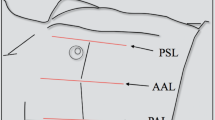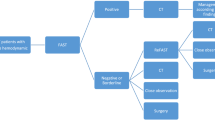Abstract
Purpose
To evaluate the feasibility of a new protocol, Chest Abdominal-Focused Assessment Sonography for Trauma (CA-FAST), during the primary survey and to estimate its diagnostic accuracy when compared with thoracoabdominal computed tomography (CT) scan.
Methods
A prospective accuracy study was performed from November 2012 to November 2013 at the Emergency Department. Only adult trauma patients who underwent a CA-FAST examination prior to a thoracoabdominal CT scan were enrolled. In addition to standard patterns detected by Extended-FAST (E-FAST) such as pneumothorax (PTX), hemothorax (HTX), pericardial and intraabdominal effusion, CA-FAST protocol also included the research of lung contusions (LCs).
Results
Six hundred and one patients were enrolled. The mean time for protocol execution was 7 ± 3 min. Chest ultrasonography showed the following results (all p < 0.001): LCs sensitivity 59 %, specificity 98 %, positive predictive value (PPV) 92 %, negative predictive value (NPV) 86 %, accuracy 87 %; PTX sensitivity 84 %, specificity 98 %, PPV 93 %, NPV 95 %, accuracy 95 %; HTX sensitivity 82 %, specificity 97 %, PPV 87 %, NPV 95 %, accuracy 94 %. The standard 4-views FAST examination showed a diagnostic accuracy of 91 % with a sensitivity of 75 %, specificity of 96 %, PPV of 81 % and NPV of 94 %.
Conclusion
According to our results CA-FAST protocol proved to be a rapid bedside method, with good accuracy and high NPV in detection of ultrasonographic patterns suggestive of serious injury in trauma patients; moreover, the additional research of LCs did not cause a delay in the diagnosis. Ultrasonography should be used as initial investigation during the primary survey, sending to further diagnostic studies (CT scan) only those patients not clearly classified.
Similar content being viewed by others
Abbreviations
- FAST:
-
Focused Assessment Sonography for Trauma
- CA-FAST:
-
Chest Abdominal-Focused Assessment Sonography for Trauma
- CT:
-
Computed tomography
- E-FAST:
-
Extended-FAST
- PTX:
-
Pneumothorax
- HTX:
-
Hemothorax
- LCs:
-
Lung contusions
- PPV:
-
Positive predictive value
- NPV:
-
Negative predictive value
- ED:
-
Emergency Department
- ATLS:
-
Advanced trauma life support
- US:
-
Ultrasonography
- X-ray:
-
Radiography
- EP:
-
Emergency physician
- ISS:
-
Injury Severity Score
References
World Health Statistics. World Health Organization 1, 45-70. Geneva: WHO Press; 2014.
American College of Surgeons. Advanced trauma life support for doctors. 10th ed. Chicago: American College of Surgeons; 2012.
Scalea TM, Rodriguez A, Chiu WC, Brenneman FD, Fallon WF Jr, Kato K, et al. Focused Assessment with Sonography for Trauma (FAST): results from an international consensus conference. J Trauma. 1999;46(3):466–72.
Rozycki GS, Ochsner MG, Schmidt JA, Frankel HL, Davis TP, Wang D, et al. A prospective study of surgeon-performed ultrasound as the primary adjuvant modality for injured patient assessment. J Trauma. 1995;39(3):492–8.
Jehle D, Davis E, Evans T, Harchelroad F, Martin M, Zaiser K, et al. Emergency department sonography by emergency physicians. Am J Emerg Med. 1989;7(6):605–11.
Arrillaga A, Graham R, York JW, Miller RS. Increased efficiency and cost-effectiveness in the evaluation of the blunt abdominal trauma patient with the use of ultrasound. Am Surg. 1999;65(1):31–5.
Miller MT, Pasquale MD, Bromberg WJ, Wasser TE, Cox J. Not so FAST. J Trauma. 2003;54(1):52–9.
Tsui CL, Fung HT, Chung KL, Kam CW. Focused abdominal sonography for trauma in the emergency department for blunt abdominal trauma. Int J Emerg Med. 2008;1(3):183–7.
Rozycki GS, Ballard RB, Feliciano DV, Schmidt JA, Pennington SD. Surgeon-performed ultrasound for the assessment of truncal injuries: lessons learned from 1540 patients. Ann Surg. 1998;228(4):557–67.
Wherrett LJ, Boulanger BR, McLellan BA, Brenneman FD, Rizoli SB, Culhane J, et al. Hypotension after blunt abdominal trauma: the role of emergent abdominal sonography in surgical triage. J Trauma. 1996;41(5):815–20.
Rozycki GS, Feliciano DV, Ochsner MG, Knudson MM, Hoyt DB, Davis F, et al. The role of ultrasound in patients with possible penetrating cardiac wounds: a prospective multicenter study. J Trauma. 1999;46(4):543–51.
Plummer D, Brunette D, Asinger R, Ruiz E. Emergency department echocardiography improves outcome in penetrating cardiac injury. Ann Emerg Med. 1992;21(6):709–12.
Ianniello S, Di G, Sessa B, Miele V. First-line sonographic diagnosis of pneumothorax in major trauma: accuracy of e-FAST and comparison with multidetector computed tomography. Radiol Med. 2014;119(9):674–80.
Kirkpatrick AW, Sirois M, Laupland KB, Liu D, Rowan K, Ball CG, et al. Hand-held thoracic sonography for detecting post-traumatic pneumothoraces: the Extended Focused Assessment with Sonography for Trauma (EFAST). J Trauma. 2004;57(2):288–95.
Lichtenstein DA, Meziere G, Lascols N, Biderman P, Courret JP, Gepner A, et al. Ultrasound diagnosis of occult pneumothorax. Crit Care Med. 2005;33(6):1231–8.
Soldati G, Testa A, Sher S, Pignataro G, La SM, Silveri NG. Occult traumatic pneumothorax: diagnostic accuracy of lung ultrasonography in the emergency department. Chest. 2008;133(1):204–11.
Hyacinthe AC, Broux C, Francony G, Genty C, Bouzat P, Jacquot C, et al. Diagnostic accuracy of ultrasonography in the acute assessment of common thoracic lesions after trauma. Chest. 2012;141(5):1177–83.
Montoya J, Stawicki SP, Evans DC, Bahner DP, Sparks S, Sharpe RP, Cipolla J. From FAST to E-FAST: an overview of the evolution of ultrasound-based traumatic injury assessment. Eur J Trauma Emerg Surg. 2015. [Epub ahead of print].
Ma OJ, Mateer JR. Trauma ultrasound examination versus chest radiography in the detection of hemothorax. Ann Emerg Med. 1997;29(3):312–5.
Sisley AC, Rozycki GS, Ballard RB, Namias N, Salomone JP, Feliciano DV. Rapid detection of traumatic effusion using surgeon-performed ultrasonography. J Trauma. 1998;44(2):291–6.
Hoff SJ, Shotts SD, Eddy VA, Morris JA Jr. Outcome of isolated pulmonary contusion in blunt trauma patients. Am Surg. 1994;60(2):138–42.
Guerrero-Lopez F, Vazquez-Mata G, Alcazar-Romero PP, Fernandez-Mondejar E, Aguayo-Hoyos E, Linde-Valverde CM. Evaluation of the utility of computed tomography in the initial assessment of the critical care patient with chest trauma. Crit Care Med. 2000;28(5):1370–5.
Soldati G, Testa A, Silva FR, Carbone L, Portale G, Silveri NG. Chest ultrasonography in lung contusion. Chest. 2006;130(2):533–8.
Stone MB, Secko MA. Bedside ultrasound diagnosis of pulmonary contusion. Pediatr Emerg Care. 2009;25(12):854–5.
American College of Emergency Physicians. Emergency ultrasound guidelines. Irvig: American College of Emergency Physicians; 2008.
Volpicelli G, Elbarbary M, Blaivas M, Lichtenstein DA, Mathis G, Kirkpatrick AW, et al. International evidence-based recommendations for point-of-care lung ultrasound. Intensive Care Med. 2012;38(4):577–91.
Zhang M, Liu ZH, Yang JX, Gan JX, Xu SW, You XD, et al. Rapid detection of pneumothorax by ultrasonography in patients with multiple trauma. Crit Care. 2006;10(4):R112.
Korner M, Krotz MM, Degenhart C, Pfeifer KJ, Reiser MF, Linsenmaier U. Current role of emergency US in patients with major trauma. Radiographics. 2008;28(1):225–42.
Nandipati KC1, Allamaneni S, Kakarla R, Wong A, Richards N, Satterfield J, Turner JW, Sung KJ. Extended focused assessment with sonography for trauma (EFAST) in the diagnosis of pneumothorax: experience at a community based level I trauma center. Injury. 2011;42(5):511-4. doi:10.1016/j.injury.2010.01.105.
Brooks A, Davies B, Smethhurst M, Connolly J. Emergency ultrasound in the acute assessment of haemothorax. Emerg Med J. 2004;21(1):44–6.
Soldati GSSCR. If you see the contusion, there is no pneumothorax. Am J Emerg Med. 2010;28(1):106–7.
Chiu WC, Cushing BM, Rodriguez A, Ho SM, Mirvis SE, Shanmuganathan K, et al. Abdominal injuries without hemoperitoneum: a potential limitation of focused abdominal sonography for trauma (FAST). J Trauma. 1997;42(4):617–23.
Shackford SR, Rogers FB, Osler TM, Trabulsy ME, Clauss DW, Vane DW. Focused abdominal sonogram for trauma: the learning curve of nonradiologist clinicians in detecting hemoperitoneum. J Trauma. 1999;46(4):553–62.
Boulanger BR, Rozycki GS, Rodriguez A. Sonographic assessment of traumatic injury. Future developments. Surg Clin N Am. 1999;79(6):1297–316.
Coley BD, Mutabagani KH, Martin LC, Zumberge N, Cooney DR, Caniano DA, et al. Focused abdominal sonography for trauma (FAST) in children with blunt abdominal trauma. J Trauma. 2000;48(5):902–6.
Dolich MO, McKenney MG, Varela JE, Compton RP, McKenney KL, Cohn SM. 2,576 ultrasounds for blunt abdominal trauma. J Trauma. 2001;50(1):108–12.
Gaarder C, Kroepelien CF, Loekke R, Hestnes M, Dormage JB, Naess PA. Ultrasound performed by radiologists-confirming the truth about FAST in trauma. J Trauma. 2009;67(2):323–7.
Labovitz AJ. Focused cardiac ultrasound in the emergent setting: a consensus statement of the American Society of Echocardiography and American College of Emergency Physicians. J Am Soc Echocardiogr. 2010;23(12):30–1225.
Leibowitz D, Perlman G, Planer D, Gilon D, Berman P, Bogot N. Quantification of pericardial effusions by echocardiography and computed tomography. Am J Cardiol. 2011;107(2):331–5.
Carrié C, Biais M, Lafitte S, Grenier N, Revel P, Janvier G. Goal-directed ultrasound in emergency medicine: evaluation of a specific training program using an ultrasonic stethoscope. Eur J Emerg Med. 2015;22(6):419–25.
Ma OJ, Gaddis G, Norvell JG, Subramanian S. How fast is the focused assessment with sonography for trauma examination learning curve ? Emerg Med Australas. 2008;20:32–7.
Blaivas M, Lyon M, Duggal S. A prospective comparison of supine chest radiography and bedside ultrasound for the diagnosis of traumatic pneumothorax. Acad Emerg Med. 2005;12(9):844–9.
Author information
Authors and Affiliations
Corresponding author
Ethics declarations
Conflict of interest
Maurizio Zanobetti, Coppa Alessandro, Nazerian Peiman, Grifoni Stefano, Scorpiniti Margherita, Innocenti Francesca, Conti Alberto, Bigiarini Sofia, Gualtieri Simona, Casula Claudia, Ticali Piero Francesco and Pini Riccardo declare that they have no conflict of interest.
Ethical standard
All procedures performed in studies involving human participants were in accordance with the ethical standards of the institutional and/or national research committee and with the 1964 Helsinki declaration and its later amendments or comparable ethical standards.
Rights and permissions
About this article
Cite this article
Zanobetti, M., Coppa, A., Nazerian, P. et al. Chest Abdominal-Focused Assessment Sonography for Trauma during the primary survey in the Emergency Department: the CA-FAST protocol. Eur J Trauma Emerg Surg 44, 805–810 (2018). https://doi.org/10.1007/s00068-015-0620-y
Received:
Accepted:
Published:
Issue Date:
DOI: https://doi.org/10.1007/s00068-015-0620-y




